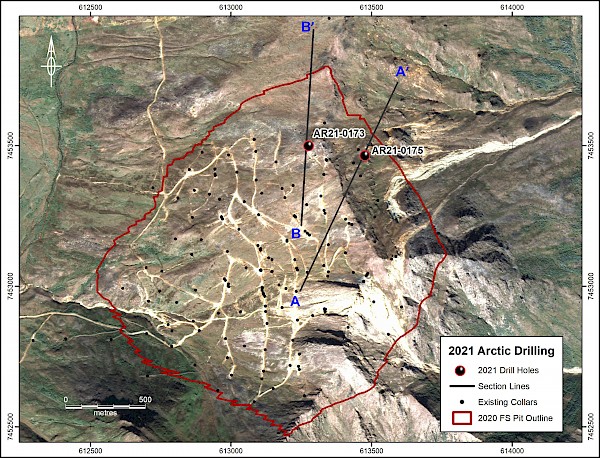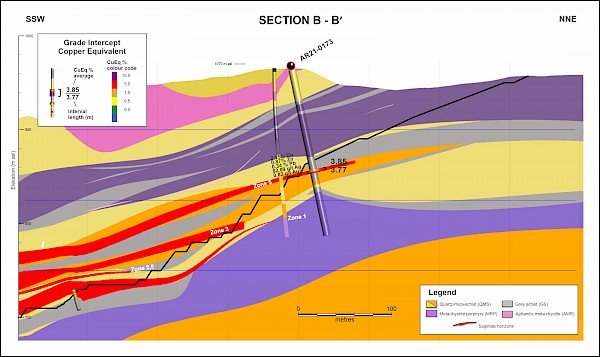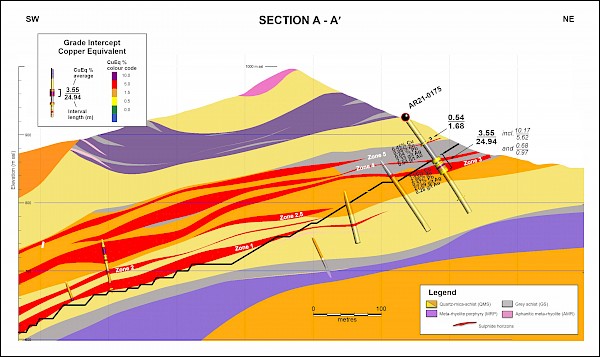First Results of the 2021 Drill Program at the Arctic Project Received; Mineralization Extends Beyond Proposed Arctic Pit
November 22, 2021
November 22, 2021 - Vancouver, British Columbia – Trilogy Metals Inc. (TSX, NYSE American: TMQ) (“Trilogy” or the “Company”) is pleased to announce the first drilling results from the 2021 summer field season at the Arctic Project, part of the Upper Kobuk Mineral Projects (“UKMP”) located in Northwestern Alaska managed by Ambler Metals LLC (“Ambler Metals”), the joint venture operating company equally owned by Trilogy and South32 Limited (ASX, LSE, JSE: S32; ADR: SOUHY) (“South32”).
The 2021 Arctic field program included 4,131 meters of diamond drilling, comprising 18 holes, that were designed to convert a portion of the resources from the Indicated category to the Measured category, and provide material for metallurgical testing and geotechnical information. The results contained in this news release are from the first two geotechnical holes of the program that were drilled at the start of the field season. The results of the remaining 16 holes are expected to come in over the next couple of months.
Highlights from the first two holes of the 2021 drill program
Drill holes AR21-0173 and AR21-0175 were drilled as part of the 2021 geotechnical program that is designed to test the northeast pit’s wall stability. Both holes show that high grade mineralization extends beyond the currently defined pit at Arctic.
Based on a cut-off grade of 0.5% copper equivalent, significant zones of high-grade copper, zinc, lead, gold, and silver mineralization were intersected, including:
- AR21-0175 intersected three mineralized intervals, including 24.94 meters of 1.85% copper, 2.96% zinc, 0.57% lead, 0.28 g/t gold and 27.09 g/t silver for a copper equivalent grade of 3.55%. Within this interval is a subinterval of 5.62 meters grading 4.94% copper, 10.57% zinc, 1.71% lead, 0.40 g/t gold and 58.90 g/t silver for a copper equivalent grade of 10.17%.
- AR21-0173 intersected one mineralized interval of 3.77 meters of 2.15% copper, 0.87% zinc, 0.34% lead, 0.83 g/t gold and 82.89 g/t silver for a copper equivalent grade of 3.85%.
The composites are based on a copper-equivalent grade of 0.5% using metal prices from Trilogy’s 2020 Arctic feasibility study ($3.00/lb copper, $1.10/lb zinc, $1.00/lb lead, $1,300/oz gold, and $18.00/oz silver) and a maximum of 3-meter internal dilution. All drill hole intercepts are close to true width.
Tony Giardini, President and CEO of Trilogy, commented, “The initial drilling results from Arctic continue to confirm our belief that the Arctic deposit is one of the highest grade polymetallic mineral projects in the world. Not only is Arctic high grade, but it also has wide zones of mineralization that are relatively close to surface. Of note is drill hole AR21-0175 which appears to extend high-grade mineralization beyond the current pit at Arctic. The latest drilling program at Arctic will assist Ambler Metals in the continued de-risking of the project and in the detailed engineering of the asset.”
Richard Gosse, Vice President, Exploration at Trilogy stated, “It is good to see the results of our 2021 drill program are beginning to come in from ALS Laboratories. Also, good to see these high-grade extensions, just outside the proposed pit and relatively close to surface, in holes that were primarily designed to collect geotechnical information. We are looking forward to seeing the results of the remaining 16 drill holes at Arctic as well as from the regional drill program.”
Significant mineralized intervals of high-grade mineralization at a cutoff of 0.5% copper equivalent are reported in Table 1. The locations of the holes are shown in Figure 1 and Table 2.
Table 1. Drill Intercepts from the 2021 Arctic Infill Drilling Program

Notes:
- Copper equivalent (CuEq) calculations use metal prices assumptions of $3.00/lb for copper, $1.00/lb for zinc, $0.90/lb for lead, $1,300/oz for gold, and $18.00/oz for silver.
- Results are core intervals and not true thickness; true widths have not been determined for the above intercepts but are believed to be representative of actual drill thicknesses.
- Significant interval defined as a minimum of 1.0 meter copper interval with average grade >0.5% CuEq.
- Cut-off grade of 0.5% CuEq.
- Internal dilution up to three meters of <0.5% CuEq.
- Intervals of <1.0 meter not reported.
- Core recovery averaged 96%.
- Minimum sample length was 0.17m, average sample length was 2.4m overall and 1.7m within mineralized zones.
- Some rounding errors may occur.
Table 2. Drill Hole Locations at the Arctic Project

Coordinates are in UTM Zone 4N (meters) coordinate system, NAD83 Datum.
Figure 1. Location of Drill Holes from the Arctic Drilling Program

Drill hole AR21-0173, which is sized HQ3 (63.5 mm diameter), was drilled as part of the 2021 geotechnical program. The hole, as seen in Figure 2, was designed to test the northeast pit’s wall stability. The intercept from 110.54 meters to 114.31 meters is interpreted to be the continuation of Zone 5. This intercept is heavily oxidized with pyrite being the only sulphide present. This intercept currently sits outside of the Arctic feasibility study pit and is located approximately 30 meters current resource area and is open to the northwest. This drill hole is located close to drill hole AR-47 which was drilled by Kennecott in 1975. An oxide rich interval is present in AR-47 which lines up with the projection of Zone 5.
Figure 2. Cross Section Showing Hole AR21-0173

Drill hole AR21-0175, which is sized HQ3 (63.5 mm diameter), was drilled as part of the 2021 geotechnical program. This hole, as seen in Figure 3, was designed to test the northeast pit’s wall stability. The intercept from 71.93 meters to 96.87 meters is interpreted to be the continuation of Zone 4 and 3. This intercept currently sits outside of the Arctic feasibility study pit and is also outside of the current mineral resource boundary. The mineralization at AR21-0175 is projected to continue for another 60 meters laterally to the surface.
Figure 3. Cross Section Showing Hole AR21-0175

Within the Arctic deposit, mineralization occurs as stratiform semi-massive sulphide to massive sulphide beds within primarily graphitic chlorite schists and fine-grained quartz schists. The sulphide beds average 4 meters in thickness but vary from less than 1 meter up to as much as 18 meters in thickness.
QA/QC Program
The drilling program, sampling and assaying protocol, and data verification were managed by qualified persons (QPs) employed by Ambler Metals. The diamond drill holes were completed using PQ3 or HQ3 diameter core, and recoveries averaged 95%. Drill core was cut lengthwise into halves using a diamond saw, and one-half was cut lengthwise to provide quarter core for sampling. The remainder of the core was retained in core trays and archived at site.
Samples were collected through mineralized zones using a 0.45 m minimum length and 3.07 m maximum length; average sample length is 1.47 m. Weights of the drill core samples range from 0.57 to 17.86 kg, depending on the size of core, rock type, and recovery.
Each core sample was placed into a bag with a numbered tag and quality control samples were inserted between core samples using the same numbering sequence. Then, samples were grouped into batches for shipping and laboratory submissions. Each batch of 20 samples contains three quality control (QC) samples that comprise one certified reference material (CRM), one core blank (BLK), and one core or crushed duplicate (DUP). Chain of custody records are maintained for sample shipments and the custody is transferred from Ambler Metals expeditor to the laboratory upon delivery.
Samples were shipped to ALS Minerals laboratory in Fairbanks, Alaska, USA, for sample preparation. ALS Minerals Fairbanks is a satellite sample preparation facility accredited under ALS Minerals. After preparation at ALS Minerals Fairbanks, split pulp samples were shipped to ALS Minerals in North Vancouver, B.C., Canada, for assaying. ALS Minerals North Vancouver is an independent laboratory certified under ISO 9001:2008 and accredited under ISO/IEC 17025:2005 by the Standards Council of Canada. ALS Minerals includes its own internal quality control samples comprising certified reference materials, blanks, and pulp duplicates.
Drill core samples were weighed (WEI-21), dried if excessively wet (DRY-21), coarse jaw crushed to 70% passing 6 mm (CRU-21), fine jaw crushed to 70% passing 2 mm (CRU-31), riffle split to 250 g subsamples (SPL-21) and pulverized to 85% passing 75 μm (PUL-31). Crushed duplicates were created by riffle splitting crushed samples into two parts.
Gold analyses were completed using a 30 g lead fire assay and AAS finish (Au-AA23). Multi-element analyses for 48 elements were completed using a geochemical four acid digestion and ICP-ES/MS finish (ME-MS61). Over-range assays for Ag, Cu, Zn, and S were completed using an ore grade four-acid digestion and ICP-ES finish (ME-OG62). Additional analyses were completed for Ba and Hg.
Au, Ag, Cu, Pb, and Zn assays for QC samples were reviewed to ensure that CRMs are within tolerance limits specified on supplier certificates, BLKs are below acceptable thresholds, and DUPs display statistical patterns normally expected for sample types, methods, and elements. CRMs that returned assays outside of tolerance limits and BLKs with assays above thresholds were deemed to have failed. Sample batches containing failed QC samples were re-assayed to ensure that the QC samples returned acceptable results before release. All QC monitoring data are reviewed and signed off by an independent QAQC geologist.
There is no known relationship between core sample recoveries and assay grades. Ambler Metals will submit 5% of the assay intervals from prospective lithologies to a laboratory independent of ALS Minerals for check assaying.
Qualified Persons
Richard Gosse, P.Geo., Vice President Exploration for Trilogy, is a Qualified Person as defined by National Instrument 43-101. Mr. Gosse has reviewed the scientific and technical information in this news release and approves the disclosure contained herein.
About Trilogy Metals
Trilogy Metals Inc. is a metal exploration and development company which holds a 50 percent interest in Ambler Metals LLC which has a 100 percent interest in the Upper Kobuk Mineral Projects (“UKMP”) in Northwestern Alaska. On December 19, 2019, South32, a globally diversified mining and metals company, exercised its option to form a 50/50 joint venture with Trilogy. The UKMP is located within the Ambler Mining District which is one of the richest and most-prospective known copper-dominant districts located in one of the safest geopolitical jurisdictions in the world. It hosts world-class polymetallic volcanogenic massive sulphide (“VMS”) deposits that contain copper, zinc, lead, gold and silver, and carbonate replacement deposits which have been found to host high-grade copper and cobalt mineralization. Exploration efforts have been focused on two deposits in the Ambler Mining District – the Arctic VMS deposit and the Bornite carbonate replacement deposit. Both deposits are located within a land package that spans approximately 172,636 hectares. Ambler Metals has an agreement with NANA Regional Corporation, Inc., an Alaska Native Corporation that provides a framework for the exploration and potential development of the Ambler Mining District in cooperation with local communities. Trilogy’s vision is to develop the Ambler Mining District into a premier North American copper producer.
Company Contact
Patrick Donnelly
Vice President, Corporate Communications & Development
moc.slatemygolirt@yllennod.kcirtap
604-630-3569
604-638-8088 or 1-855-638-8088
# # #
Cautionary Note Regarding Forward-Looking Statements
This press release includes certain "forward-looking information” and "forward-looking statements” (collectively "forward-looking statements”) within the meaning of applicable Canadian and United States securities legislation including the United States Private Securities Litigation Reform Act of 1995. All statements, other than statements of historical fact, included herein, including, without limitation, statements relating to interpretation of drill results; our beliefs regarding the potential of the Arctic Project; our expectations regarding de-risking of the Arctic Project; are forward-looking statements. Forward-looking statements are frequently, but not always, identified by words such as "expects”, "anticipates”, "believes”, "intends”, "estimates”, "potential”, "possible”, and similar expressions, or statements that events, conditions, or results "will”, "may”, "could”, or "should” occur or be achieved. Forward-looking statements involve various risks and uncertainties. There can be no assurance that such statements will prove to be accurate, and actual results and future events could differ materially from those anticipated in such statements. Important factors that could cause actual results to differ materially from the Company's expectations include the uncertainties involving impact of the COVID-19 pandemic; success of exploration activities, permitting timelines, requirements for additional capital, government regulation of mining operations, environmental risks, prices for energy inputs, labour, materials, supplies and services, uncertainties involved in the interpretation of drilling results and geological tests, unexpected cost increases and other risks and uncertainties disclosed in the Company’s Annual Report on Form 10-K for the year ended November 30, 2020 filed with Canadian securities regulatory authorities and with the United States Securities and Exchange Commission and in other Company reports and documents filed with applicable securities regulatory authorities from time to time. The Company's forward-looking statements reflect the beliefs, opinions, and projections on the date the statements are made. The Company assumes no obligation to update the forward-looking statements or beliefs, opinions, projections, or other factors, should they change, except as required by law.
